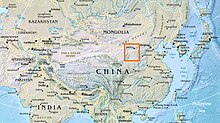 | |
| Geographical range | Ordos Plateau |
|---|---|
| Period | late Neolithic to early Bronze Age |
| Dates | c. 800–150 BCE |
| Preceded by | Zhukaigou culture Shimao culture Siwa culture Xicha culture |
| Followed by | Han dynasty |
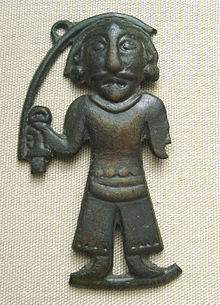
The Ordos culture (simplified Chinese: 鄂尔多斯文化; traditional Chinese: 鄂爾多斯文化; pinyin: È'ěrduōsī Wénhuà) was a material culture occupying a region centered on the Ordos Loop (corresponding to the region of Suiyuan, including Baotou to the north, all located in modern Inner Mongolia, China) during the Bronze and early Iron Age from c. 800 BCE to 150 BCE. The Ordos culture is known for significant finds of Scythian art and may represent the easternmost extension of Indo-European Eurasian nomads, such as the Saka, or may be linkable to Palaeo-Siberians or Yeniseians. Under the Qin and Han dynasties, the area came under the control of contemporaneous Chinese states.
Background
The Ordos Plateau was covered by grass, bushes, and trees and was sufficiently watered by numerous rivers and streams to produce rich grazing lands. At the time, it contained the best pasture lands on the Asian Steppe.
Equestrian nomads from the north-west occupied the area previously settled by the Zhukaigou culture and the Shimao culture from the 6th to the 2nd century BCE before being driven away by the Xiongnu. Some authors date the arrival from the north and west of these nomads practicing mounted warfare to the 4th century BC, corresponding roughly to the period of the conquests of Alexander the Great in Central Asia. They came in several waves from Central Asia and Southern Siberia through the Gansu corridor before settling in the Ordos region. They may have interacted with the Yuezhi in the process.
This also roughly corresponds to the period when mounted warfare was introduced in the Chinese state of Zhao, during the Warring States period, by groups called by the Chinese Hu (胡, "Nomads") or Donghu (東胡 "Eastern Nomads") and the Linhu (林胡 "Forest Nomads"), who stimulated the interest of the Zhao king with their "archery from horseback" (騎射 qíshé). Sometimes, Chinese sources clearly differentiated the Hu and the Xiongnu, who consolidated their eastern empire by the end of the 3rd century BC. yet on other occasions Chinese sources often just classified the Xiongnu as a Hu people, which was a blanket term for nomadic people.
Early characteristics

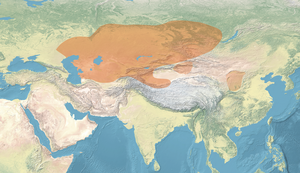
khovoSha-
jingSubeshiSlab-grave
cultureDONGHUSABEANSOrdos
culturePazyrykTagarChandmanSaglyJINDian
cultureMACEDONIAN EMPIRENANDA
EMPIREZHOU
DYNASTYMEROËScythiansSauro-
matiansMassagetaeDahaeclass=notpageimage| General location of the Ordos culture and the Saka realm ( ), and contemporary Asian polities c. -325
The Ordos are mainly known from their skeletal remains and artifacts. The Ordos culture of about 500 BCE to 100 CE is known for its "Ordos bronzes", blade weapons, finials for tent-poles, horse gear, and small plaques and fittings for clothes and horse harness, using animal style decoration with relationships both with the Scythian art of regions much further west, and also Chinese art. Its relationship with the Xiongnu is controversial; for some scholars they are the same and for others different. Many buried metal artefacts have emerged on the surface of the land as a result of the progressive desertification of the region.

The Ordos are thought to be the easternmost of the Iranian peoples of the Eurasian Steppe, just to the east of the better-known Yuezhi, also an Indo-European-speaking people. Because the people represented in archaeological finds tend to display Europoid features, also earlier noted by Otto J. Maenchen-Helfen, Iaroslav Lebedynsky suggests the Ordos culture had "a Scythian affinity". Other scholars have associated it with the Yuezhi or the Palaeo-Siberians (specifically, Yeniseians). The weapons found in tombs throughout the steppes of the Ordos are very close to those of the Scythians and Saka. The Ordos culture has strong similarities with the Shajing culture in Gansu to the west, the Saka culture of the Xinjiang, and the Upper Xiajiadian culture of Liaoning to the northeast.
Recent archeological and genetic data suggests that the Western and Eastern Scythians of the 1st millennium BC originated independently, but both combine Yamnaya-related ancestry, which spread eastwards from the area of the European steppes, with an East Asian-related component, which most closely corresponds to the modern North Siberian Nganasan people of the lower Yenisey River, to varying degrees, but generally higher among Eastern Scythians.
On the other hand, archaeological evidence now tends to suggest that the origins of Scythian culture, characterized by its kurgans burial mounds and its Animal style of the 1st millennium BC, are to be found among Eastern Scythians rather than their Western counterparts: eastern Scythian kurgans (such as the Altaic kurgan Arzhan 1 in Tuva) are older than western Scythian kurgans, and elements of the Animal style are first attested in areas of the Yenisei river and modern-day China in the 10th century BC. The rapid spread of Scythian culture, from the Eastern Scythians to the Western Scythians, is also confirmed by significant east-to-west gene flow across the steppes during the 1st millennium BC.
The Maoqinggou culture at the eastern edge of the Ordos area is also considered as a "Scythian culture", which ultimately disappeared in the 3rd-2nd centuries BCE with the onset of the Xiongnu. Their culture expanded tremendously, and in the northeast of China replaced earlier cultures such as the Upper Xiajiadian.
Early bronze artifacts (6-5th century BC)




 Scythian-style daggers from Maoqinggou, 6th century BC, and chariot yoke ornaments, Ordos, (5-4th century BC) Bronze sword distribution in Bronze culture around Ordos culture
Scythian-style daggers from Maoqinggou, 6th century BC, and chariot yoke ornaments, Ordos, (5-4th century BC) Bronze sword distribution in Bronze culture around Ordos culture
Several Ordos artifacts from the 6-5th century BC reflect a nomadic culture based on the chariot rather than the mounted horse. These include chariot ornaments for chariot yokes, which have been excavated in nomadic tombs.
The material used was bronze, in contrast to the silver and gold which appeared from the 4th century BC, together with the mounted-horse culture. Chariot ornaments disappeared from graves around that time. The artifacts were probably created in the foundries of the pre-Dynastic State of Qin for the nomadic herders of the Ordos.
In Northeast Asia, adjacent to the Ordos-style bronze dagger culture are the Liaoning-style bronze dagger and the Slender bronze dagger, which influence each other. Influenced by the Ordos-style bronze dagger, the Antenna-style bronze dagger was established in South Manchuria, Korea, and Northern Kyushu.
Introduction of new metallurgy and style (4th-3rd century BC)
Around the 4th century BC, grave goods starting to change markedly. The chariot, which had been a central funerary artifact among nomadic people, was replaced by the horse. The iconography of grave artifacts became clearly derived from Altaic or Northern Asian motifs. The new iconography of this period, combined with the fact that it first appears in southern Ningxia and southeastern Gansu to the west of the Ordos, suggests that these horse-mounted nomads came from Northern Asia and southern Siberia through Gansu, probably in several waves.
Gold and silver replaced tinned bronze. A Gold stag with eagle's head found at the southern edge of the Ordos desert exemplifies the new "intrusive style" introduced by the Ordos nomads. The motif of the "raptor-headed creature" is earlier documented from the Pazyryk culture, and is part of a Eurasian symbolic system known from around the 7th century BC and identified in Saka burial sites. A nomadic gold crown was also excavated in the Ordos, and dated to the 3rd century BC. New techniques such as granulation were also introduced from the west across Eurasia and would then be adopted by China.
These artifacts, such as those depicting raptor-headed mythological creatures, are often attributed to the Xiongnu, but this is an impossibility since the Xiongnu were not yet in the region in the 4th century BCE and could not have imported these designs to northwestern China, and furthermore these styles actually disappeared soon after the arrival of the Xiongnu. They should instead be attributed to the pre-Xiongnu nomads would occupied the Ordos at that time, including possibly the Yuezhi.
-
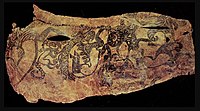 Pazyryk tattoo design with zoomorphic symbols, 4th century BC. A precursor of the new Ordos designs.
Pazyryk tattoo design with zoomorphic symbols, 4th century BC. A precursor of the new Ordos designs.
-
 Gold stag with eagle's head, characteristic of the new style introduced by the Ordos nomads. Excavated at the southern border of the Ordos desert.
Gold stag with eagle's head, characteristic of the new style introduced by the Ordos nomads. Excavated at the southern border of the Ordos desert.
-
 Nomadic gold crown excavated in the Ordos, 3rd century BC
Nomadic gold crown excavated in the Ordos, 3rd century BC
-
 Gold belt buckle in Scythian style, from Xigoupan M2 (4th–3rd c. BCE)
Gold belt buckle in Scythian style, from Xigoupan M2 (4th–3rd c. BCE)
Contact with neighbouring peoples

While the ethnolinguistic origins and character of the Ordos culture are unknown, the population appears to have been significantly influenced by Indo-European cultures. However, the art of the Ordos culture appears to have similarities to that of the Donghu people (Chinese: 東胡), a Mongolic-speaking nomadic tribe located to the east, suggesting that the two had close ties.
The Ordos population was also in contact – and reportedly often at war – with the pre-Han and Han peoples. The Ordos culture covered, geographically, regions later occupied by the Han, including areas just north of the later Great Wall of China and straddling the northernmost hook of the Yellow River.
To the west of the Ordos culture was another Indo-European people, the Yuezhi, although nothing is known of relations between the two. (The Yuezhi were later vanquished by the Xiongnu and Wusun, who reportedly drove them westward, out of China; a subgroup of the Yuezhi is widely believed to have migrated to South Central Asia, where it constituted the ruling elite of the Kushan Empire.)
Arrival of the Xiongnu (circa 160 BC)

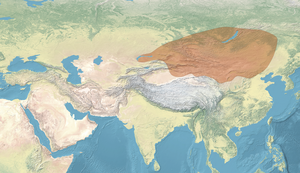 -150GRECO
-150GRECOBACTRIANSPAR-
THIASargatShuleINDO-
GREEKSSAKASKorgantasYUEZHISABEANSOrdos
cultureJINTagarSaglyWUSUNDian
cultureSELEUCID
EMPIREMAURYA
EMPIREHAN
DYNASTYXIONGNUKhotanPTOLE-
MIESMEROËSarmatiansAlansSha-
jingclass=notpageimage| Territory of the Xiongnu in the 2nd century BC (before the Han–Xiongnu War of 133 BC – 89 AD): includes Mongolia, East Kazakhstan, East Kyrgyzstan, South Siberia, and parts of northern China including Western Manchuria, Xinjiang, Inner Mongolia and Gansu.
The Xiongnu's early appearance was recorded north of Wild Goose Gate and Dai commanderies before 265 BCE, just before the Zhao-Xiongnu War; however, sinologist Edwin Pulleyblank (1994) contends that pre-241-BCE references to the Xiongnu are anachronistic substitutions for the Hu people instead. They are also mentioned in Chinese sources, official ones like Records of the Grand Historian, and unofficial ones like Yi Zhou Shu and Classic of Mountains and Seas as having occupied the Ordos plateau during the Warring States period before it was occupied by the states of Qin and Zhao. It is generally thought to be their homeland; however, when exactly they came to occupy the region is unclear and archaeological finds suggest it might have been much earlier than traditionally thought. The Xiongnu regained their homeland up to China's borders, more than ten years after their expulsion, during the post-Qin chaos when Meng Tian had died and convicts stationed to guard the borders returned home.
As the Xiongnu expanded southward into Yuezhi territory around 160 BCE under Modun, the Yuezhi in turn defeated the Sakas and pushed them away at Issyk Kul. It is thought the Xiongnu also occupied the Ordos area during the same period, when they came in direct contact with the Chinese. From there, the Xiongnu conducted numerous devastating raids into Chinese territory (167, 158, 142, 129 BCE).
The Han–Xiongnu War began with Emperor Gaozu of Han, and the Han colonized the area of the Ordos as the commandery of Shuofang in 127 BCE. Prior to this campaign, there were already earlier commanderies established by Qin and Zhao before they were overrun by the Xiongnu in 209 BCE.
Xiongnu period artifacts
Belt plaques in the shape of a kneeling horse in gilded silver, were made in North China for Xiongnu patrons in 3rd-1st century BCE. Belt buckles with animal combat scenes were made in the 2nd-1st century BCE, mainly by North China workshops for the Xiongnu. These plates were inspired by the art of the steppes, but the design was flattened and compressed within the frame.
-
 Belt buckle with paired felines attacking ibexes, derived from earlier Scythian art. Ordos, 3rd century BC. Usually described as Xiongnu despite early date.
Belt buckle with paired felines attacking ibexes, derived from earlier Scythian art. Ordos, 3rd century BC. Usually described as Xiongnu despite early date.
-
 Belt plaque with design of wrestling men, Ordos region and western part of North China, 2nd century BC, bronze - Ethnological Museum, Berlin
Belt plaque with design of wrestling men, Ordos region and western part of North China, 2nd century BC, bronze - Ethnological Museum, Berlin
-
Silver horse, Ordos, 4th–1st century BCE
-
Belt buckle, Ordos, 3rd–1st century BCE
-
Horse attacked by tiger, Ordos, 4th-1st century BCE
References
Citations
- Honeychurch, William (2015). Inner Asia and the Spatial Politics of Empire: Archaeology, Mobility, and Culture Contact (PDF). p. 112. doi:10.1007/978-1-4939-1815-7. ISBN 978-1-4939-1814-0.
- Maenchen-Helfen, Otto; Helfen, Otto (1 January 1973). The World of the Huns: Studies in Their History and Culture. University of California Press. p. 371. ISBN 978-0-520-01596-8.
- The Silk Road Encyclopedia. Seoul Selection. 18 July 2016. p. 1959. ISBN 978-1-62412-076-3.
- Honeychurch, William (2015). Inner Asia and the Spatial Politics of Empire: Archaeology, Mobility, and Culture Contact (PDF). p. 112. doi:10.1007/978-1-4939-1815-7. ISBN 978-1-4939-1814-0.
- Lebedynsky 2007, p. 131
- ^ Macmillan Education 2016, p. 369 "From that time until the HAN dynasty the Ordos steppe was the home of semi-nomadic Indo-European peoples whose culture can be regarded as an eastern province of a vast Eurasian continuum of Scytho-Siberian cultures."
- ^ Harmatta 1992, p. 348: "From the first millennium b.c., we have abundant historical, archaeological and linguistic sources for the location of the territory inhabited by the Iranian peoples. In this period the territory of the northern Iranians, they being equestrian nomads, extended over the whole zone of the steppes and the wooded steppes and even the semi-deserts from the Great Hungarian Plain to the Ordos in northern China."
- ^ "The genetic and linguistic evidence for the xiongnu-yenisseian hypothesis". ResearchGate. Retrieved 1 February 2022.
- ^ Hanks & Linduff 2009, pp. 284–286
- Beckwith 2009, p. 71
- Bunker 2002, pp. 26–29
- ^ Bunker 2002, p. 26
- ^ Bunker 2002, pp. 27–28
- Thierry 2005.
- Shiji "Hereditary House of Zhao" quote: "今中山在我腹心,北有燕,東有胡,西有林胡、樓煩、秦、韓之邊,而無彊兵之救,是亡社稷,柰何?" translation: "Now Zhongshan is at our heart and belly , Yan to the north, Hu to the east, Forest Hu to the west, Loufan, Qin, Han at our borders. Yet we have no strong army to help us, surely we will lose the country. What is to be done?"
- Stratagems of the Warring States, "King Wuling spends his day in idleness", quote: "自常山以至代、上黨,東有燕、東胡之境,西有樓煩、秦、韓之邊,而無騎射之備。" Jennifer Dodgson's translation: "From Mount Chang to Dai and Shangdang, our lands border Yan and the Donghu in the east, and to the west we have the Loufan and shared borders with Qin and Han. Nevertheless, we have no mounted archers ready for action."
- Pulleyblank 1994, p. 518. sfn error: no target: CITEREFPulleyblank1994 (help)
- Di Cosmo, Nicola. 2002. Ancient China and its Enemies: The Rise of Nomadic Power in East Asian History. Cambridge University Press. p. 129.
- Pulleyblank 1994, p. 519-520. sfn error: no target: CITEREFPulleyblank1994 (help)
- Compare this and this account, both from the 1970s. Bunker, 200, sees them as the same, or rather the Ordos people as a subgroup of the Xiongnu.
- Bunker 2002, p. 200
- Maenchen-Helfen 1973, pp. 369–375
- Lebedynsky 2007, p. 125 "Europoid faces in some depictions of the Ordos, which should be attributed to a Scythian affinity"
- Lebedynsky 2007, p. 125 "The Mongoloid types of the Transbaikal area and Central and Eastern Mongolia are strongly contrasted with the Europoid type displayed at the same time by the Scythian nomads occupying Western Mongolia and their predecessors of the Bronze age."
- Lebedynsky 2007, p. 127
- Cosmo, Nicola Di (1999). Northern Frontier in Pre-Imperial China (Cambridge History of Ancient China). Cambridge University Press. pp. 951–952.
The Saka culture in Xinjiang, the Shajing culture in Gansu, the Ordos complex in Inner Mongolia, and the Upper Xiajiadian culture of Liaoning, all point to a transition from mixed agropastoral to predominantly or exclusively pastoral nomadic cultures. From the seventh century onwards, objects related to improved horse management and horse riding, such as the bit, cheekpieces, horse masks, and bell ornaments, became ever more widespread and sophisticated.
- ^ Unterländer, Martina; Palstra, Friso; Lazaridis, Iosif; Pilipenko, Aleksandr; Hofmanová, Zuzana; Groß, Melanie; Sell, Christian; Blöcher, Jens; Kirsanow, Karola; Rohland, Nadin; Rieger, Benjamin (3 March 2017). "Ancestry and demography and descendants of Iron Age nomads of the Eurasian Steppe". Nature Communications. 8: 14615. Bibcode:2017NatCo...814615U. doi:10.1038/ncomms14615. ISSN 2041-1723. PMC 5337992. PMID 28256537.
"Genomic inference reveals that Scythians in the east and the west of the steppe zone can best be described as a mixture of Yamnaya-related ancestry and an East Asian component. Demographic modelling suggests independent origins for eastern and western groups with ongoing gene-flow between them, plausibly explaining the striking uniformity of their material culture. We also find evidence that significant gene-flow from east to west Eurasia must have occurred early during the Iron Age." and "The blend of EHG and Caucasian elements in carriers of the Yamnaya culture was formed on the European steppe and exported into Central Asia and Siberia". We therefore considered an alternative model in which we treat them as a mix of Yamnaya and the Han (Supplementary Table 25). This model fits all of the Iron Age Scythian groups, consistent with these groups having ancestry related to East Asians not found in the other populations. Alternatively, the Iron Age Scythian groups can also be modelled as a mix of Yamnaya and the north Siberian Nganasan (Supplementary Note 2, Supplementary Table 26).
- ^ Unterländer, Martina; Palstra, Friso; Lazaridis, Iosif; Pilipenko, Aleksandr; Hofmanová, Zuzana; Groß, Melanie; Sell, Christian; Blöcher, Jens; Kirsanow, Karola; Rohland, Nadin; Rieger, Benjamin (3 March 2017). "Ancestry and demography and descendants of Iron Age nomads of the Eurasian Steppe". Nature Communications. 8: 14615. Bibcode:2017NatCo...814615U. doi:10.1038/ncomms14615. ISSN 2041-1723. PMC 5337992. PMID 28256537.
The origin of the widespread Scythian culture has long been debated in Eurasian archaeology. The northern Black Sea steppe was originally considered the homeland and centre of the Scythians until Terenozhkin formulated the hypothesis of a Central Asian origin. On the other hand, evidence supporting an east Eurasian origin includes the kurgan Arzhan 1 in Tuva, which is considered the earliest Scythian kurgan. Dating of additional burial sites situated in east and west Eurasia confirmed eastern kurgans as older than their western counterparts. Additionally, elements of the characteristic 'Animal Style' dated to the tenth century BCE were found in the region of the Yenisei river and modern-day China, supporting the early presence of Scythian culture in the East.
- Pankova, Svetlana; Simpson, St John (21 January 2021). Masters of the Steppe: The Impact of the Scythians and Later Nomad Societies of Eurasia: Proceedings of a conference held at the British Museum, 27-29 October 2017. Archaeopress Publishing Ltd. p. 523. ISBN 978-1-78969-648-6.
In the eastern end of the Scythian world in northern China, in the area of Lake Daihai to the northwest of Ordos, there is a Scythian culture known as Maoqinggou.
- Di Cosmo, Nicola (2008). The Cambridge History of Ancient China From the Origins of Civilization to 221 BC. Chapter 13THE NORTHERN FRONTIER IN PRE-IMPERIAL CHINA. Cambridge University Press. pp. 885–966.
BRONZE PRODUCTION. Bronze objects from Scythian sites in northern China comprise fairly typical nomadic objects, which have a wide distribution throughout the Eurasian steppe belt. Among these the most characteristic are the straight blade double-edged dagger, horse gear, large ritual cauldrons, ornamental plaques, and belt buckles. The daggers from Ordos sites such as Taohongbala and Maoqinggou are different from those of the Shang and early Zhou periods. A new and rapidly spread ornamental feature is the dagger pommel with facing bird heads, or Antennae Style. This motif is very common to the north and west, and is found widely in South Siberia. (...) The consensus today is that the nomadic cultures of the Northern Zone in the late Warring States were directly linked to earlier inhabitants such as those of the lower strata of Taohongbala and Maoqinggou. There is no doubt, however, that the culture represented by these earlier sites expanded tremendously and, in certain areas such as the northeast, replaced earlier cultures such as Upper Xiajiadian.
- Matsumoto, Keita (1 January 2021). "A SURVEY OF BRONZE AND EARLY IRON AGE TOOLS AND WEAPONS FROM NORTHERN MONGOLIA". Ancient cultures of Mongolia, Southern Siberia and Northern China: 332.
- ^ "Metropolitan Museum of Art". www.metmuseum.org.
- Bunker 2002, pp. 64–65.
- Bunker 2002, p. 69 item 35.
- "Finial British Museum". The British Museum.
- ^ Park Sun Mi 2020, pp. 159–185 harvnb error: no target: CITEREFPark_Sun_Mi2020 (help)
- Kiyotaka Nishie 2019, pp. 173–193 harvnb error: no target: CITEREFKiyotaka_Nishie2019 (help)
- ^ Bunker 2002, pp. 23–24
- ^ Bunker 2002, p. 30
- Lebedynsky 2007, p. 124.
- Coatsworth, John; Cole, Juan; Hanagan, Michael P.; Perdue, Peter C.; Tilly, Charles; Tilly, Louise (16 March 2015). Global Connections: Volume 1, To 1500: Politics, Exchange, and Social Life in World History. Cambridge University Press. p. 138. ISBN 978-1-316-29777-3.
- Atlas of World History. Oxford University Press. 2002. p. 51. ISBN 978-0-19-521921-0.
- Fauve, Jeroen (2021). The European Handbook of Central Asian Studies. BoD – Books on Demand. p. 403. ISBN 978-3-8382-1518-1.
- Shiji Vol. 81 "Stories about Lian Po and Lin Xiangru - Addendum: Li Mu" text: "李牧者,趙之北邊良將也。常居代鴈門,備匈奴。" translation: "About Li Mu, he was a good general at Zhao's northern borders. He often stationed at Dai and Wild Goose Gate, prepared the Xiongnu."
- Theobald, Ulrich (2019) "Li Mu 李牧" in ChinaKnowledge.de - An Encyclopaedia on Chinese History, Literature and Art
- Pulleyblank 1994, p. 520. sfn error: no target: CITEREFPulleyblank1994 (help)
- Schuessler (2014), p. 264
- Shiji Vol. 110 "Account of the Xiongnu". quote: "後秦滅六國,而始皇帝使蒙恬將十萬之眾北擊胡,悉收河南地。…… 匈奴單于曰頭曼,頭曼不勝秦,北徙。" translation: "Later on, Qin conquered six other states, and the First Emperor dispatched general Meng Tian to lead a multitude of 100,000 north to attack the barbarians (Hu); he took all lands south the Yellow River. The Xiongnu chanyu was Touman; Touman could not win against Qin, so he fled north."
- Lost Book of Shu, "Explaining the King's Gatherings". Quotes: "... 正北空同、大夏、莎車、姑他、旦略、豹胡、代翟、匈奴、樓煩、月氏、孅犁、其龍、東胡,請令以橐駝、白玉、野馬、騊駼、駃騠、良弓為獻。" translation: "(Yi Yin to Tang of Shang:) When rectifying the north, the Kongtong, Daxia, Shache, Guta, Danlüe, Baohu, Dai di, Xiongnu, Loufan, Yuezhi, Xianli, Qilong, Donghu, (I) ask (your Majesty) to command (them) to bring camels, white jade, wild horses taotu jueti, good bows as tributes."
- Shan Hai Jing, "Classic of Regions Within the Seas: South" text: "海內東南陬以西者。 匈奴、開題之國、列人之國並在西北。" translation: "Within the Seas: south-eastern corner westwards. The Xiōngnú, Kāití's countries, those listed peoples' countries exist side-by-side in the Northwest."
- Pulleyblank 1994, p. 516, 519-523. sfn error: no target: CITEREFPulleyblank1994 (help)
- Ma 2005, pp. 220–225.
- Shiji Vol. 110 "Account of the Xiongnu" quote: "十餘年而蒙恬死,諸侯畔秦,中國擾亂,諸秦所徙適戍邊者皆復去,於是匈奴得寬,復稍度河南與中國界於故塞。"
- Lebedynsky 2007, p. 131.
- Ma 2005, p. 224.
- ^ Bunker 2002, p. 29.
- ^ "Metropolitan Museum of Art". www.metmuseum.org.
- ^ Bunker 2002, pp. 29, 101 item 68.
- Bunker 2002, p. 106, item 74.
- "Metropolitan Museum of Art". www.metmuseum.org.
- Kim, Moon-Ja (Professor, Dept. of Clothing & Textiles, Suwon University, Korea) (2006). "A Study on the Scythian Buckle" (PDF). Journal of Fashion Business. 10 (6): 49.
{{cite journal}}: CS1 maint: multiple names: authors list (link) - So, Jenny F.; Bunker, Emma C. (1995). Traders and raiders on China's northern frontier. Seattle : Arthur M. Sackler Gallery, Smithsonian Institution, in association with University of Washington Press. pp. 22 & 90. ISBN 978-0-295-97473-6.
- Bunker 2002, p. 104 item 72.
Sources
- Andreeva, Petya (2020). "Animal Style at the Penn Museum: Rethinking Portable Steppe Art and Its Visual Tropes". Orientations. 51 (4).
- Beckwith, Christopher I. (16 March 2009). Empires of the Silk Road: A History of Central Eurasia from the Bronze Age to the Present. Princeton University Press. ISBN 978-1400829941. Retrieved 18 February 2015.
- Bunker, Emma C. (2002). Nomadic art of the eastern Eurasian steppes: the Eugene V. Thaw and other New York collections (fully available online). New York: The Metropolitan Museum of Art. ISBN 9780300096880.
- Hanks, Brian K.; Linduff, Katheryn M. (30 August 2009). Social Complexity in Prehistoric Eurasia: Monuments, Metals and Mobility. Cambridge University Press. ISBN 978-0521517126. Retrieved 13 March 2015.
- Harmatta, János (1992). "The Emergence of the Indo-Iranians: The Indo-Iranian Languages". In Dani, A. H.; Masson, V. M. (eds.). History of Civilizations of Central Asia: The Dawn of Civilization: Earliest Times to 700 B. C. (PDF). UNESCO. pp. 346–370. ISBN 978-92-3-102719-2. Retrieved 29 May 2015.
- Lebedynsky, Yaroslav (2007). Les nomades. Éditions Errance. ISBN 9782877723466.
- Macmillan Education (2016). Macmillan Dictionary of Archaeology. Macmillan International Higher Education. ISBN 978-1349075898.
- Maenchen-Helfen, Otto (1973). The World of the Huns: Studies in Their History and Culture. University of California Press. ISBN 0520015967. Retrieved 18 February 2015.
- Ma, Liqing (2005). The Original Xiongnu, An Archaeological Exploration of the Xiongnu's History and Culture. Hohhot: Inner Mongolia University Press. ISBN 7-81074-796-7.
- Thierry, François (2005). "Yuezhi et Kouchans, Pièges et dangers des sources chinoises". In Bopearachchi, Osmund; Boussac, Marie-Françoise (eds.). Afghanistan, Ancien carrefour entre l'est et l'ouest. Turnhout: Brepols. pp. 421–539. ISBN 978-2-503-51681-3.
- Pulleyblank, Edwin G. "Ji Hu: Indigenous Inhabitants of Shaanbei and Western Shanxi". Opuscula Altaica: Essays Presented in Honor of Henry Schwarz: 499–531.
- Schuessler, Axel (2014). "Phonological Notes on Hàn Period Transcriptions of Foreign Names and Words" (PDF). Studies in Chinese and Sino-Tibetan Linguistics: Dialect, Phonology, Transcription and Text. Language and Linguistics Monograph Series (53). Taipei, Taiwan: Institute of Linguistics, Academia Sinica.
External links
- The Relief Plaques of Eastern Eurasia and China - The Ordos Bronzes - video by Sir John Boardman, 3m 47 sec
| Prehistoric cultures of China | |
|---|---|
| Northeastern China | |
| Upper Yellow River | |
| Middle Yellow River | |
| Lower Yellow River | |
| Middle and Upper Yangtze | |
| Lower Yangtze and Huai | |
| Southern China | |
| Tibet | |
| Xinjiang | |
| Taiwan | |
| Other | |